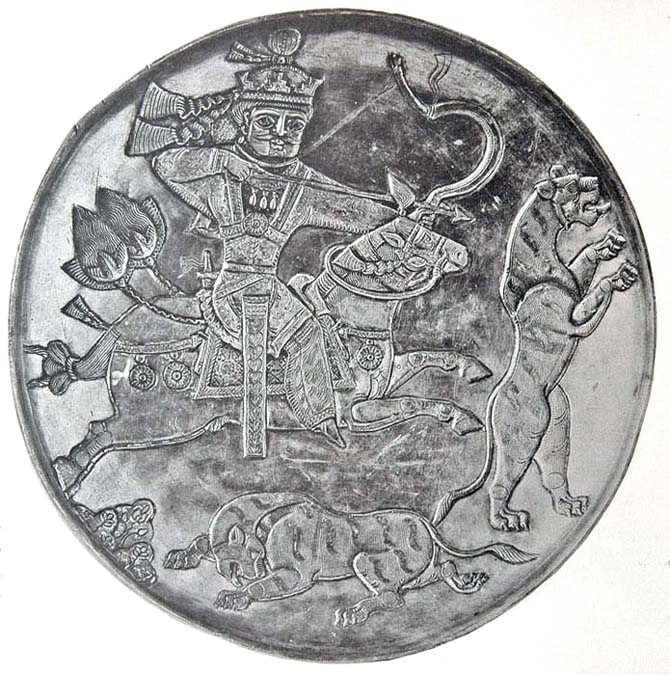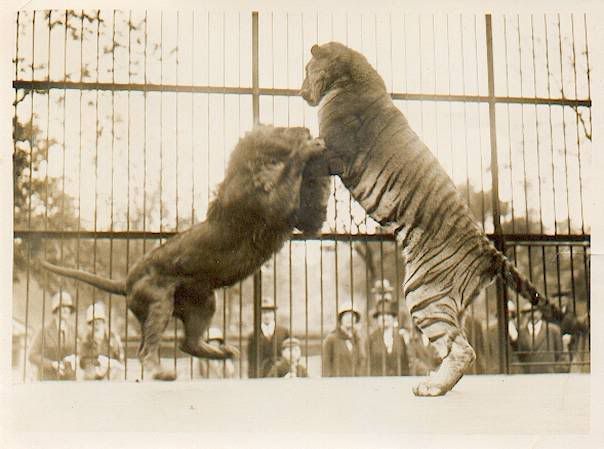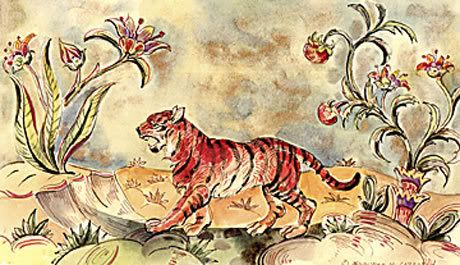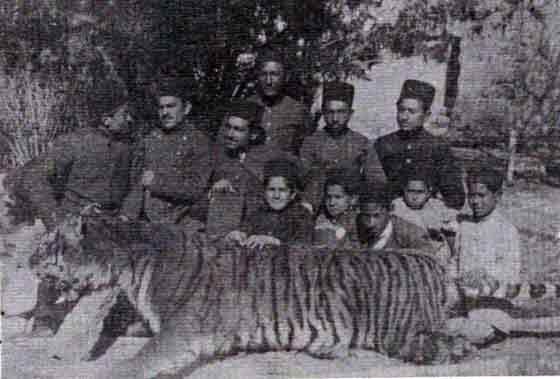|
|
Post by sebbe67 on Jul 17, 2008 22:56:33 GMT
This reminded me on the people who talk stories about big foots and moas which they have seen in recent years. So i would give nothing to such stories from people which only intension it is to came into the media. By the way the guy who allegedly have photographed the Chinese tiger last year was unmasked as lyer. [/quote] I don't think its quite fair to compare recently extinct animals such as the Caspian tiger with creatures like the Bigfoot or the moa birds, there is no credibility in any of the many observations made of the so called "Bigfoot", while the moas became extinct a long time ago and if such a big bird still existed some credible proof of their continued existence would certainly have surfaced by now. There has been plenty of unconfirmed reports of the Caspian Tigers for the last 30 years, I personally believe that the Caspian Tiger is extinct now, but I must say I wouldn't be very surprised if it did still exist in some areas some 20 years ago, but the fact remains that the distribution of the Caspian Tiger was largely limited to remote and very rarely visited areas, especially the last populations must have been confined to very remote areas. The recent case regarding the supposedly rediscovery of the South Chinese Tiger in the wild was suspected by be a "made up story" at a quite early stage but it was impossible to proof it as the photographer refused to reveal the exact location where he had photographed the animal, he did get his fair share of attention and it was clearly his purpose. It will be very hard to confirm most records made of the Caspian Tiger since the 1960s-1970s as no photographs evidence seems to exist to back up these records up of "recently" shot/sighted individuals. There is possibly that some concrete evidence to back these records up exist somewhere. |
|
|
|
Post by sebbe67 on Jul 17, 2008 23:00:23 GMT
We were talking in a cement factory about a completly different subject and this gentleman has NO media interest whatso ever. It was a casual line in a conversation, like I said I'll have a look in the museum tomorrow (Friday prayers permitting). Please tell us if you find anything in the museum, records like these are defenitely worth following up. |
|
|
|
Post by Melanie on Jul 17, 2008 23:42:00 GMT
I feel sorry for my behaviour. But i have thought, if there was really a Caspian tiger killed ten years ago there must have been some media releases who have reported about that case.
|
|
dp43
Junior Member
 
Posts: 5
|
Post by dp43 on Jul 18, 2008 10:25:55 GMT
No offense taken ;D, unfortunately the museum was closed today but I will return tomorrow. 10 years ago in this region there was still lot of trouble post Gulf War 1, the region is still "difficult" with Iran shelling the boarder areas. The fate of one tiger would not be a high priority -unfortunately.
|
|
|
|
Post by another specialist on Jul 19, 2008 3:36:43 GMT
Yes, I would agree with that dp43
|
|
dp43
Junior Member
 
Posts: 5
|
Post by dp43 on Jul 19, 2008 17:09:03 GMT
I now know the museum is closed Friday, Saturday & Sunday, I fly out on Tuesday but will try again in 6 weeks.
|
|
|
|
Post by another specialist on Jul 20, 2008 16:04:05 GMT
Ok mate we can wait.
|
|
|
|
Post by temujin on Aug 13, 2008 4:18:18 GMT
Some artistical representantions of the Caspian tiger: A bronze axe from Uzbekistan,circa 1000-800 BC.In that bronze, made by the Scythians(a iranian people of the Russian steppe,wich repelled a persian invasion of Darius I in 512 BC),there is a fight between a tiger, a goat and a wild boar.  That is a golden plate from Western Siberia,with a battle between a griffine and a tiger.That plate,which data is don't find,was made by the sarmatians,a iranian people too.The sarmatians succeded the scythians in the Russian steppe and around 370 was replaced in that area by the Huns.Both pictures are present in the book "Nomad people of the steppes",of E.D.Phillips. ![]() depts.washington.edu/silkroad/museum depts.washington.edu/silkroad/museum s/shm/hermitagepazyry k1a.jpg[/img] From the famous Pazyryk tombs in the Altai mountains,a fragment of a saddle-cloth hanging depicting a tiger.Uncertain data,probably 6th or 5th century BC.  A silver dish with a king hunting tigers of of Sassanid Persia,dated from the first half of the 7th century.  That is the Iwan of the Sher-Dor madrassa(a islamic colegial),in the Registan square,near the Ulugh-Beg and Tilla Kari madrassas.The Sher-Dor madrassa was built between 1619 and 1636 by the shibanid emir Yalangtush of the Khanate of Bukhara.Note the tigers hunting your and the sun of Iran present in his coasts and the mosaics of the Iwan.  That is a type of toy of painted wood with a tiger seated in a tabble with wheels from the XIX century,during the Qajar Dinasty of Iran. If i found more of that artistical representations of the Caspian tiger i will post in the topic.
|
|
|
|
Post by another specialist on Aug 13, 2008 15:01:07 GMT
|
|
|
|
Post by Peter on Aug 13, 2008 18:27:41 GMT
Also for me the time I see it. Do you know more on the origin of this photograph? Any more information? Or somebody else?
|
|
|
|
Post by another specialist on Aug 13, 2008 19:58:19 GMT
|
|
|
|
Post by another specialist on Aug 13, 2008 20:08:14 GMT
Also for me the time I see it. Do you know more on the origin of this photograph? Any more information? Or somebody else? At present unable to find any further information on it. |
|
dp43
Junior Member
 
Posts: 5
|
Post by dp43 on Sept 16, 2008 15:08:25 GMT
Finally got into Sulaymaniyah museum, but no tiger skin. There wasn't any tiger imagery reflected in the pottery either, not that was on display. I have a meeting with the gentlemen who told me the original story later this week, I'll check the detail again.
Although I feel if the skin does exist it may be hanging on some officials wall by now.
|
|
|
|
Post by sebbe67 on Oct 24, 2008 22:34:03 GMT
Was kept in Berlin (Zoologischer Garten) Zoo around 1900. Hamburg Zoo: 1955 to 1960 Single animal the last copy of this subspecies in Europe, came with Onager transport from Persia. zootierliste.de |
|
|
|
Post by another specialist on Jan 14, 2009 7:59:58 GMT
Caspian tiger used 'silk road' The Press Association Jan 13, 2009 Long before merchants trod the "Silk Road" through China, ancestors of modern tigers chose the same route to reach central Asia, research suggests. A genetic study, published online in the journal PLoS One, has shown that the central Asian Caspian tiger, which became extinct in 1970, was almost identical to the Siberian tiger found in far-eastern Russia today. Scientists have concluded that the two are so similar because both were descended from the same migrating ancestor. Researcher Carlos Driscoll, from the University of Oxford, said: "What these striking results indicate is that extinct Caspian tigers and modern Siberian tigers are molecular nearest neighbours. In a sense it means that the Caspian tigers never became extinct." The route Caspian tigers took to get to central Asia from south-east Asia some 10,000 years ago has been a puzzle because they seemed isolated from other populations by the massive Tibetan plateau. The new research suggests that rather than skirting round the plateau, via India to the south or Siberia to the north, they went through it along China's narrow Gansu Corridor. Thousands of years later this would form part of the "Silk Road" trading route. The new look at the tiger family tree indicates that the South China tiger, now extinct in the wild, may be the big cat most closely resembling the ancestor of all modern tigers. Mr Driscoll, a Phd student, said: "We came very close to losing the chance to study the South China tiger, even from a molecular standpoint, simply because it is so rare. Hopefully our findings will encourage the Chinese government to focus conservation efforts on this most endangered of living tigers." Professor David Macdonald, director of the Wildlife Research Conservation Unit at Oxford University and co-author of the study, said: "The fact that the Caspian tiger was driven extinct in 1970 is an indictment of the modern age and not some long-gone piece of history. "Our research indicates that the Caspian tiger's genes still exist, in the form of the Siberian tiger, so they could be restored to central Asia. This restoration would obviously be a huge undertaking but what a triumph it would be." Copyright © 2009 The Press Association. All rights reserved. Kevin M. Stewart Western Canada Wilderness Committee Project Mkono website ecn.ab.ca/~puppydog Growing a Truffula Forest blog: d.livejournal. com/ The Daily Humorscope (http://www.humorsco pe.com/) Aries - Saturday, March 18, 2006 "You may lose sight of what is truly important to you, if you're not careful. In other words, it not whether you win or lose, it's whether you end up with your leg in a cast for 3 months." www.google.com/hostednews/ukpress/article/ALeqM5ihB_mBj39oAp3uMbuh-kq7ypX9iQ |
|
|
|
Post by Melanie on Jan 14, 2009 10:44:48 GMT
Complete article in PLOS One: www.plosone.org/article/info%3Adoi%2F10.1371%2Fjournal.pone.0004125Caspian tiger used 'silk road' The Press Association Jan 13, 2009 Long before merchants trod the "Silk Road" through China, ancestors of modern tigers chose the same route to reach central Asia, research suggests. A genetic study, published online in the journal PLoS One, has shown that the central Asian Caspian tiger, which became extinct in 1970, was almost identical to the Siberian tiger found in far-eastern Russia today. Scientists have concluded that the two are so similar because both were descended from the same migrating ancestor. Researcher Carlos Driscoll, from the University of Oxford, said: "What these striking results indicate is that extinct Caspian tigers and modern Siberian tigers are molecular nearest neighbours. In a sense it means that the Caspian tigers never became extinct." The route Caspian tigers took to get to central Asia from south-east Asia some 10,000 years ago has been a puzzle because they seemed isolated from other populations by the massive Tibetan plateau. The new research suggests that rather than skirting round the plateau, via India to the south or Siberia to the north, they went through it along China's narrow Gansu Corridor. Thousands of years later this would form part of the "Silk Road" trading route. The new look at the tiger family tree indicates that the South China tiger, now extinct in the wild, may be the big cat most closely resembling the ancestor of all modern tigers. Mr Driscoll, a Phd student, said: "We came very close to losing the chance to study the South China tiger, even from a molecular standpoint, simply because it is so rare. Hopefully our findings will encourage the Chinese government to focus conservation efforts on this most endangered of living tigers." Professor David Macdonald, director of the Wildlife Research Conservation Unit at Oxford University and co-author of the study, said: "The fact that the Caspian tiger was driven extinct in 1970 is an indictment of the modern age and not some long-gone piece of history. "Our research indicates that the Caspian tiger's genes still exist, in the form of the Siberian tiger, so they could be restored to central Asia. This restoration would obviously be a huge undertaking but what a triumph it would be." Copyright © 2009 The Press Association. All rights reserved. Kevin M. Stewart Western Canada Wilderness Committee Project Mkono website ecn.ab.ca/~puppydog Growing a Truffula Forest blog: d.livejournal. com/ The Daily Humorscope (http://www.humorsco pe.com/) Aries - Saturday, March 18, 2006 "You may lose sight of what is truly important to you, if you're not careful. In other words, it not whether you win or lose, it's whether you end up with your leg in a cast for 3 months." www.google.com/hostednews/ukpress/article/ALeqM5ihB_mBj39oAp3uMbuh-kq7ypX9iQ |
|
|
|
Post by another specialist on Feb 12, 2009 10:46:47 GMT
Extinct Tiger Lives On in Close Relative By Elizabeth Pennisi ScienceNOW Daily News 14 January 2009Don't call it a comeback, but the regal Caspian tiger--thought to have gone extinct nearly 40 years ago--lives on in a closely related subspecies, a new genetic analysis reveals. Conservationists say they can use these relatives to help reestablish the Caspian tiger in Central Asia, parts of which are no longer inhabited by people and have plenty of suitable prey. Once among the most widespread animals in Asia, tigers are now gone from more than 90% of their habitat. Biologists broke the original population down into eight subspecies, based on looks and geography, from the relatively small and dark Indochinese tiger of southern continental Asia to the massive Siberian tiger of the Russian far east. In 2004, researchers for the first time applied DNA analysis to the tiger family tree and confirmed the existence of five extant subspecies. But the Caspian tiger, the last of which was shot in Turkey in 1970, remained an enigma. These tigers were isolated from other tiger populations by the Tibetan Plateau, leaving their origins a mystery. So researchers from the University of Oxford in the United Kingdom and the U.S. National Cancer Institute (NCI) Laboratory of Genomic Diversity in Frederick, Maryland, again turned to DNA. Oxford's Carlos Driscoll and his colleagues collected tissue from 20 of the 23 known Caspian tiger specimens kept in museums across Eurasia. NCI's Stephen O'Brien and colleagues then sequenced parts of five mitochondrial genes, which evolve rapidly and thus accumulate changes that can help distinguish subspecies. "That's allowed them to develop a picture of the distribution of tigers in a way that we haven't had before," says John Seidensticker, a tiger conservation biologist at the Smithsonian National Zoological Park in Washington, D.C. Caspian tiger DNA was readily distinguishable from most other tigers' DNA. But when the team compared the genome of the Caspian tiger with that of the Siberian, or Amur, tiger, only one letter of genetic code separated them. Thus, the two subspecies are really one, with the supposed Siberian tiger splitting off from the Caspian tiger in the past century, Driscoll and his colleagues report today in PLoS ONE. The genetic data indicate that the ancestor of the Caspian tiger spread westward from China along what became the Silk Road. Then these tigers expanded northward and eastward, establishing what is now the range of the Siberian tiger. The researchers suggest that through the early 1900s, Caspian and Siberian tiger populations intermingled, but hunters subsequently isolated the two groups. The find is good news for tiger conservation. "This is very exciting," says Seidensticker. "[We've] just lost part of a subspecies as opposed to a whole subspecies." Furthermore, he says, "we now know what source population to use to restore tigers in the Caspian Range." And because zoo-breeding programs for Siberian tigers are so successful, recovery efforts can use zoo stock. That leaves two other extinct tigers to sort out: the Bali tigers and the Javan tigers, both from Indonesia. Efforts are under way to collect DNA and pin down their place on the tiger family tree. . sciencemag. org/cgi/content/ full/2009/ 114/2 |
|
|
|
Post by Peter on Mar 7, 2009 9:31:27 GMT
This is very exciting news! It means that the Caspian Tiger might not be extinct, but lives on as the Siberian Tiger. The research has shown that there is not enough genetic difference between the two subspecies to call them two different subspecies. If accepted the Siberian name: Panthera tigris altaica Temminck, 1884 will become a synonym of the Caspian name Panthera tigris virgata (Illiger, 1815). Reading the PLoS article, it looks like the Caspian tiger might not be extinct at all....  ;D |
|
|
|
Post by another specialist on Apr 10, 2009 18:52:54 GMT
|
|
|
|
Post by temujin on Apr 21, 2009 2:53:26 GMT
That studies are very interesting.So,accordliyng to that studies the northern tigers was a great population wich encompassed from Korea and the Amur mouth in the east to the northern and southern coasts of the Black Sea and from the Lena Basin in the north to northern Iraq in the south.But i think that more research is need to confirm that.And about that photo,there are more informations??.Because the source of that photo is in farsi and i only say few words in that language(incluind babr wich means tiger).
|
|













 ;D
;D